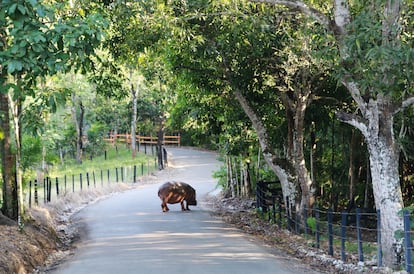Pablo Escobar’s hippos make a dramatic move to Mexico
Scientists want Colombia’s Ministry of Environment to release a study on the proper course of action for this invasive species


The heated debate over Pablo Escobar’s imported hippopotamuses is missing a prominent voice — Colombia’s Ministry of Environment. Many have weighed in on what to do with this invasive species, but Environment Minister Susana Muhamad is not one of them. In the meantime, department officials in Antioquia, northwest Colombia, have launched a plan to send 70 hippos abroad — 10 to Mexico and 60 to India. The first 10 are scheduled to leave in two months for Mexico, a move that will be filmed by an Argentinean production company for an episode of Cargas Imposibles (or, Impossible Cargo), a television series about shipments that require extra-special handling.
While giving away 70 hippos is a good starting point, it doesn’t fully solve the problem. Scientists have asked Minister Muhamad on Twitter to publish the results of a study conducted six months ago by Colombia’s National University and the Alexander Von Humboldt Institute. The study assessed the impacts of the growing hippo population on the people living in surrounding areas.
The study aimed to “propose actions for the management, control and eradication of Hippopotamus amphibius, through the analysis of the socio-environmental, demographic and ecological dimension of the species.” Still, the study’s results have not been published. On March 27, Muhammad finally tweeted back. “Based on the study results, we are defining the general policy and budget for the next four years.” She added that they expect to announce their decisions in April.
That’s all we know from Muhamad’s ministry about the environmental risk posed by the booming hippo herd in Colombia. According to the most recent study published in 2021 in Biological Conservation, the country’s hippo population is projected to exceed 1,400 in 2034. Nataly Casteblanco, a co-author of the study, believes the number may be even higher because their latest analysis indicates a 15% reproduction rate, and almost half of the current population are infants and juveniles. The estimated number today is 160 hippos.
The last information about hippos posted to the Ministry of Environment’s website dates back to the previous administration of President Iván Duque, so scientists are eager to see the recent study’s results. Anticipating a presentation, an abstract of the study was submitted for the upcoming Colombian Zoology Congress but was later withdrawn. EL PAÍS received no response from the Ministry of Environment when asked why the study presentation was canceled.
Antioquia’s televised hippo relocation
Meanwhile, Antioquia not-so-quietly decided to relocate at least 70 hippos to Mexico and India. In late March, Antioquia Governor Aníbal Gaviria signed an agreement with Ernesto Zazueta, the president of the Ostok animal sanctuary in Sinaloa, Mexico, to take the first 10 hippos. “We must acknowledge that their presence and uncontrolled future growth pose risks to our citizens and visitors. As an invasive species, it could endanger other native species,” said Gaviria.
Three recent incidents involving humans have been reported in the Magdalena Medio region where the hippos live. One person was seriously bitten and continues to suffer mental health problems. A man trying to steal a calf to sell was attacked by its mother. The most widely publicized incident was a road accident. In September 2017, a hippopotamus strolled through the village of Doradal and was adopted as a pet by locals who didn’t realize that the world’s third-largest land animal kills 500 people annually in Africa.
The hippo relocation to Mexico promises to be a spectacle. The Argentinean production company will film it and pay for the crates used to transport the animals. The municipality of Puerto Triunfo will build corrals to lure and hold the hippos, and Antioquia’s environmental agency will be responsible for capturing them. They will then be placed in special crates, quarantined and transported in trucks to Medellín’s airport or the nearby air base at Palanquero. From there, on to Ostok.
Zazueta, the entrepreneurial head of the Ostok sanctuary, said they just want to help control the hippo population growth rate. “A radical move was needed. It didn’t make sense to take one or two hippos, but enough to bring the population down [in Colombia],” he said. The relocation has ruffled feathers back in Mexico. “I’ve heard some people are worried and say, ‘Why are you bringing a plague here?’ But Ostok is a closed sanctuary. It’s not a zoo and can’t be accessed from the street. We have containment areas for these animals.”
According to the Antioquia governor’s office, the transfer will occur in two months once the Ministry of Environment approves what Gaviria called a “passport for the hippopotamuses,” referring to the CITES (Convention on International Trade in Endangered Species of Wild Fauna and Flora) permit.
According to Lina Marcela Ríos, Antioquia’s animal protection manager, the “hippopotamuses are innocent,” and this relocation will eliminate the need to hunt the animals — a last resort. The Ministry of Environment has not said whether it agrees with Antioquia’s initiative or if it is considering other ways to control the invasive species.
All the rhetoric from officials involved at the national, regional and local levels focuses on preserving life. That’s why the hippos have become such a huge dilemma. “Our mission is to save the lives of hippos and protect the people in the Magdalena Medio area. Two phenomenal objectives,” said Gaviria, amid growing anticipation about the fate of the hippos.
Sign up for our weekly newsletter to get more English-language news coverage from EL PAÍS USA Edition
Tu suscripción se está usando en otro dispositivo
¿Quieres añadir otro usuario a tu suscripción?
Si continúas leyendo en este dispositivo, no se podrá leer en el otro.
FlechaTu suscripción se está usando en otro dispositivo y solo puedes acceder a EL PAÍS desde un dispositivo a la vez.
Si quieres compartir tu cuenta, cambia tu suscripción a la modalidad Premium, así podrás añadir otro usuario. Cada uno accederá con su propia cuenta de email, lo que os permitirá personalizar vuestra experiencia en EL PAÍS.
¿Tienes una suscripción de empresa? Accede aquí para contratar más cuentas.
En el caso de no saber quién está usando tu cuenta, te recomendamos cambiar tu contraseña aquí.
Si decides continuar compartiendo tu cuenta, este mensaje se mostrará en tu dispositivo y en el de la otra persona que está usando tu cuenta de forma indefinida, afectando a tu experiencia de lectura. Puedes consultar aquí los términos y condiciones de la suscripción digital.










































